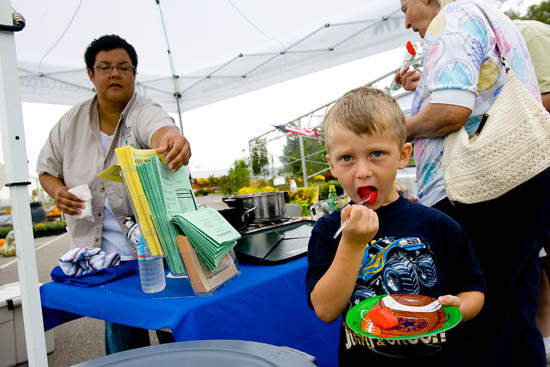Sampling impacts purchases at farmers markets
Sampling impacts purchases at farmers markets

When vendors offered samples at their farmers market booths, they saw an immediate effect on what customers purchased. The 2011 Regional Farm Market Sampling Survey, a Web-based survey conducted by researchers in the University of Kentucky College of Agriculture, determined that 55 percent of respondents purchased the sampled product the same day, though they had not originally planned to do so.
“Direct marketing opportunities, such as farmers markets, have proved to be a popular way for small- to medium-sized producers to increase revenue,” said Tim Woods, UK agricultural economist who directed the study. “Sampling has the potential to increase it further.”
Woods and Miranda Hileman, also of UK’s Department of Agricultural Economics, have recently written and released Best Practices for Sampling at Farmers Markets: A Practical Guide for Farmers Market Vendors, a manual for farmers and farmers market managers interested in learning the best practices of providing samples to patrons. The manual was funded through a grant from the U.S. Department of Agriculture Federal State Market Improvement Program.
Kentucky farmers pushed for and received new state legislation in 2009 that allows Kentucky food producers to offer food samples at registered Kentucky farmers markets without requiring food handling permits, though vendors must be certified through the Kentucky Department of Agriculture’s sampling certification program. So far, more than 1,100 producers have completed the training. Many vendors, however, still do not provide samples. Hileman believes it’s because the process felt overwhelming.
“From previous vendor surveys we found that sampling was often noted as ‘a hassle,’ and ‘labor constraints’ were an issue facing many vendors,” Hileman said. “Some also noted that they were ‘uncertain about the benefits of sampling.’ We wanted to measure consumer perceptions about sampling in order to share this information with farmers market vendors.”
The Kentucky Department of Agriculture expects the more than 2,490 food producers taking part in Kentucky farmers markets to report approximately $12 million in revenue in 2012. The growth in the number of registered farmers markets over the last eight years—from 91 in 2004 to 147 in 2012—is an indication of consumers’ increased interest in local food products and their desire to build relationships with producers.
Woods’ and Hileman’s study consisted of 3,406 responses from farmers market patrons across eight states, who had had a previous food sampling experience. Responses indicated that vendor friendliness, sample presentation, market atmosphere, sampling with friends or family and interaction with the vendor significantly impacted how the patrons felt about the sampling event. They concluded that the impact derived from sampling experiences extends to future purchases and referrals, and many vendors might find that going through the certification process is worth it, because it means increasing their customer base, and in turn, their revenues.
Best Practices for Sampling at Farmers Markets: A Practical Guide for Farmers Market Vendorsis available online for free at http://www.ca.uky.edu/cmspubsclass/files/extensionpubs/2012-19.pdf. Woods will also discuss their findings at 1:30 p.m. EST Jan. 7 during the 2013 Kentucky Fruit and Vegetable Conference and Trade Show at the Embassy Suites Hotel in Lexington. A complete agenda for the conference is available at http://kyvga.org.
Community & Leadership Development Agricultural Economics Research


